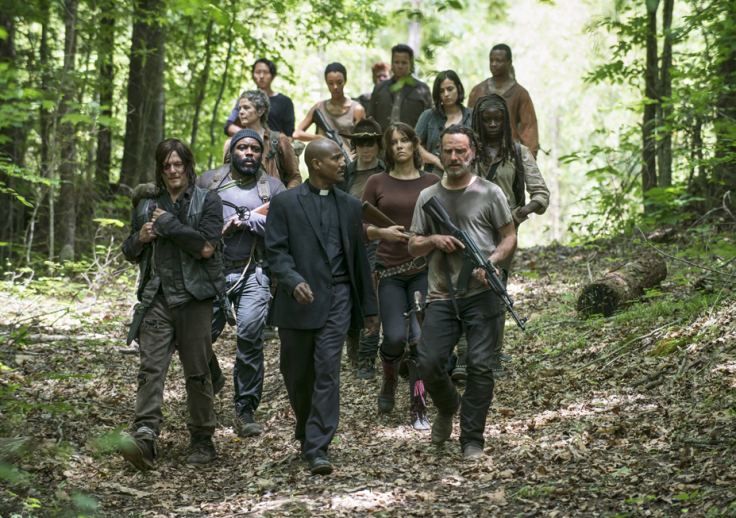AMC's 'Walking Dead' Cannibal Storyline Raises The Gore Factor But Hasn't Scared Off Ad Dollars

"Women taste better," says the cannibal in the latest episode from this season's "Walking Dead" on AMC. "They have an extra layer of fat, you know, for childbearing. Even the skinny women have it."
AMC’s “The Walking Dead” has been on for five seasons, and the zombie apocalypse drama has distinguished itself as the most explicitly violent show on cable. But apparently, crushed skulls, macheted heads, gauged eyes and zombie-disembowelment aren't enough. This season, a man’s leg was eaten right in front of him by cannibals -- who seem to have discerning palates. "The Walking Dead" is still pulling phenomenal ratings, but is the taboo-breaking content going to scare away viewers -- or advertisers? How violent is too violent for TV? And on cable TV, does it even matter?
If it does, advertisers are looking the other way, according to Brad Adgate, senior vice president of research for Horizon Media. That’s probably because the show has an exceptional ability to attract viewers in the younger demographic so coveted by advertisers.
”Viewers love it,” Adgate said. “It’s extraordinary that in the last few years, the highest-rated scripted show is on entertainment cable, not broadcast. It attracts a young audience ... a median age of 33. Given the number of viewers, that’s an accomplishment.”
The Season 5 premiere of "Walking Dead" drew 17.3 million total viewers, making it the highest-rated episode in the series' history, exceeding by over 1 million viewers its Season 4 premiere numbers of 16.1 million.
And if its roster of high-end advertisers -- including Apple, Dreamworks, Android and Google -- is any indication, it's going to take more than a gourmand cannibal to get them to flinch. The show -- like its characters -- is killing it. And making a killing. According to Ad Age’s annual pricing survey, the enduring zombie-apocalypse drama earns upwards of $400,000 for a package of spots, making it the most expensive scripted series on television for advertisers. In fact, the show is second only to the NFL in its ability to bring in advertising revenue.
The violence not only attracts viewers but also gives the show a decided edge over its broadcast competitors, Adgate says. “Cable is grittier than broadcast TV,” he said. “Some shows are trying to catch up. It has a competitive advantage that it exploits. Because it’s on cable, it can get away with more violence. That’s harder to replicate by a broadcast network.”
While other cable networks also trade in gory fare (FX’s “American Horror Story” comes to mind), “Walking Dead is the industry leader,” according to Adgate. A spokesperson for AMC did not respond to requests for comment.
About the taboo-crossing cannibalism, Adgate is blithe. "Audiences know it's fiction. Of course every marketer has a threshold, but 'Walking Dead' hasn't crossed it yet. It's a ratings juggernaut. If anything, they're going to have to beat themselves and raise the bar in storylines."
Television historian Tim Brooks, a former executive at USA Network, is unfazed by all of the brouhaha over violence on TV. It’s a concern, he said, that comes up about every 10 years, when suddenly there’s a surge in violence on television. But for the most part, studies show that the effect of violence on viewers not predisposed to violence tends to be nil. Or the studies end up being inconclusive.
When Brooks was at USA, executives there became nervous, he said, when an academic study singled out “Walker, Texas Ranger” -- his network’s most popular show starring martial arts star Chuck Norris -- as the most violent show on TV. Focus groups were called in, and surprisingly, parents raved about it, he said, saying that they watched it with their kids. When a moderator came in to explain why they’d been called in, asking them their reaction to the show being named the most violent, most of the parents were nonchalant. They said they saw the show as good vs. evil, right vs. wrong. “Walker was noble, loved children,” said Brooks. “The villains were black-hearted. The violence wasn’t explicit.”
Which brings us to the entrails-dripping “Walking Dead.” Its zombies “generalize threats like Ebola and terrorist attacks,” said Brooks. “It’s an escape into a cartoon. You know the heroes are going to [be] captured and tortured, but in the last 10 minutes they’ll make it.”
Ultimately, he said, the “Walking Dead” is not about zombies, violence and mayhem but rather the human ability to survive, a cultural reassurance that institutions work, and a belief in the solidarity of friends and family.
“The secret sauce of ‘The Walking Dead’ is the survivors,” said Brooks, “not the zombies. How they intereact, work together, their mixed motives, jealousies. It’s all about them. Zombies are the extras. They’re cartoonish. They add violence and gore, but it’s a cartoon. Very few people expect a zombie apocalypse.”
We might argue the “secret sauce” is actually blood. Lots of it. From both humans and zombies alike.
© Copyright IBTimes 2024. All rights reserved.






















